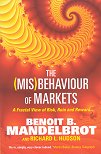The classic view of market behaviour is Gaussian, memoryless changes to prices: random walks. This leads to a very low probability of large changes. But we've experienced several crashes: real markets seem more turbulent. Mandelbrot discusses these issues, and says that the evidence demonstrates that real market behaviour follows "fat tailed" power laws, with long term memory: they have a fractal structure. Such behaviour has a much higher chance (many many many orders of magnitude) of large fluctuations (so, "million to one chances happen nine times out of ten"). So the classic theory gives an extremely skewed view of risk, and people can lose lots of money.
Mandelbrot agrees that his own multifractal theory of market prices, started in the 60s and gradually refined over the decades, is not yet finalised, but that nevertheless it is a much better fit to observations than the classic theory. He argues extremely strongly, and compellingly, for a proper science of finance: it is too important to be left to guesswork, intuition, and outmoded theories. His theory might not help you make money, but it could stop you losing it all in one big crash.
This is a fascinating book, very readable, with lots of food for thought.
